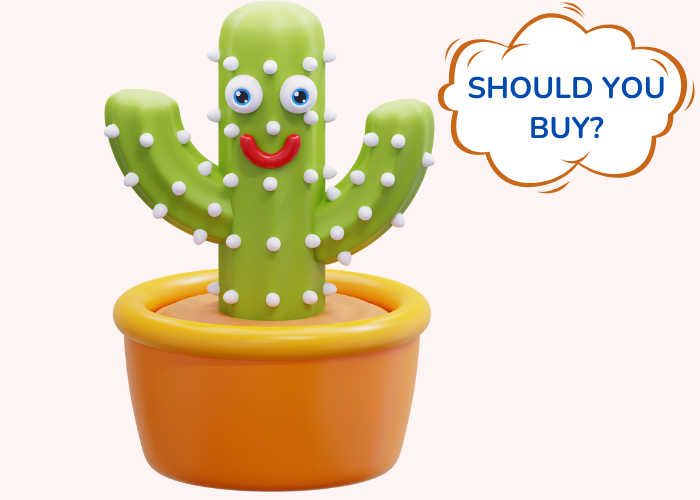
Dancing Cactus Toy : Is it worth Your Investment?
Topic
Dancing Cactus Toy : Is it worth Your Investment?
May start as early as
2.5 Years
─────────
Related Skills
Introduction
Parenthood is full of exciting moments one of them is watching your child discover joy through toys. Among the recent viral sensations in the world of children’s toys, the Dancing Cactus Toy has caught every parent’s attention. Its cheerful music, funny dances, and ability to mimic sounds have made it a favorite among toddlers and even adults.
But beyond the giggles and cuteness, parents are asking: Is the Dancing Cactus Toy really worth the investment?
Does it support development or is it just another flashy gadget?
In this blog, we break down everything you need to know about this trending toy from its developmental benefits to potential drawbacks and age recommendations so you can make an informed choice for your little one.
What We Will Cover in This Blog
What makes the Dancing Cactus Toy so popular among toddlers
The developmental benefits and learning opportunities it offers
The drawbacks and safety concerns parents should be aware of
Age and safety recommendations for use
Expert insights from UpTodd’s child specialists
Common parent FAQs on toy safety, cleaning, and maintenance
The Appeal of the Dancing Cactus Toy
The Dancing Cactus Toy became popular for its unique ability to dance, sing, and mimic speech in a humorous way. Designed with bright colors, flashing lights, and rhythmic movement, it instantly captures a child’s attention.
This toy operates as an interactive learning tool that responds to sounds and words, encouraging children to talk, sing, and engage. For many toddlers, it serves as their first exposure to cause-and-effect play when they speak, the toy “talks” back.
Pros and Cons of Dancing Cactus toy
We will be getting into this deeper Step wise
Pros of the Dancing Cactus Toy
1. Supports Language Development
One of the biggest benefits of the Dancing Cactus Toy is its contribution to language development.
When toddlers hear it repeat their words or sing songs, they’re motivated to speak more clearly, explore new sounds, and expand their vocabulary.
According to UpTodd’s language experts, interacting with toys that respond to sound can stimulate the speech centers in the brain. Children start to connect words with responses, reinforcing early communication skills.
In short, this toy can become a fun introduction to conversational learning for children aged 2.5 years and above.
2. Encourages Gross Motor Skills
One of the biggest benefits of the Dancing Cactus Toy is its contribution to language development.
When toddlers hear it repeat their words or sing songs, they’re motivated to speak more clearly, explore new sounds, and expand their vocabulary.
According to UpTodd’s language experts, interacting with toys that respond to sound can stimulate the speech centers in the brain. Children start to connect words with responses, reinforcing early communication skills.
In short, this toy can become a fun introduction to conversational learning for children aged 2.5 years and above.
3. Boosts Emotional Engagement
The toy’s cheerful expressions and repetitive tunes often bring laughter and excitement. This positive reinforcement encourages emotional connection and helps children express happiness through play.
For toddlers who are shy or reserved, such engaging toys can encourage social confidence and interaction with others.
4. Promotes Sensory Exploration
The combination of sound, light, and motion makes the Dancing Cactus Toy a multi-sensory experience. Children are naturally drawn to movement and sound, and the toy satisfies their curiosity while helping develop sensory coordination a foundation for cognitive growth.
Cons of the Dancing Cactus Toy
1. Overstimulation and Creativity Loss
While the toy is fun and engaging, it may sometimes lead to overstimulation. Constant lights, movement, and sounds can overwhelm toddlers and reduce opportunities for imaginative play.
Experts warn that heavy exposure to electronic toys can limit creativity, as children rely on the toy for entertainment rather than creating their own stories or activities.
Balancing electronic toys with traditional, open-ended toys like blocks or wooden puzzles is crucial.
You can read more here: Why Wooden Toys Must Be Your Baby’s Toys
2. Potential for Sensory Overload
Children with sensory sensitivities might find the toy’s combination of flashing lights and loud music overwhelming. Parents should observe their child’s reactions if the toy causes discomfort or irritability, it’s best to limit playtime or lower the volume.
3. Electronic Dependency
Since it’s an electronic toy, the Dancing Cactus requires batteries to operate. This not only means regular maintenance but also adds a risk of battery leakage or damage if not handled properly. Parents must ensure the battery compartment is secure and inaccessible to children.
4. Possible Choking Hazards
Like many interactive toys, small parts can sometimes come loose due to wear and tear. Parents should inspect the toy regularly to ensure there are no detachable or damaged pieces that could pose a choking risk.
Age Recommendations and Material Safety
The Dancing Cactus Toy is generally recommended for children aged 2.5 to 5 years. At this stage, toddlers are curious, communicative, and physically active the ideal combination for enjoying the toy’s benefits.
The toy is made of durable fabric, plastic casing, and an internal electronic unit. Always check that the product meets child safety certifications and contains non-toxic materials.
Supervised play is essential, especially for younger children under three.
Expert View: Dr. Priya, Child Development Specialist (UpTodd)
“The Dancing Cactus Toy can be both educational and entertaining when used mindfully. It encourages language skills, rhythm, and coordination but parents must balance its use with traditional play. A mix of interactive and imaginative activities ensures children develop both creativity and cognitive strength. The key is moderation use it as a learning supplement, not a substitute for human interaction.”
How to Introduce the Dancing Cactus Toy Safely
- Limit playtime to short intervals (15–20 minutes) to prevent overstimulation.
- Supervise usage to ensure the child interacts positively and doesn’t try to open the toy.
- Mix activities combine electronic play with outdoor games or storytelling.
- Check batteries regularly for leaks and remove them when the toy isn’t used for long periods.
- Observe your child’s reaction discontinue use if it causes distress or sensory discomfort.
Conclusion
The Dancing Cactus Toy is a delightful mix of fun, music, and movement. It can encourage your toddler’s speech, rhythm, and motor development while keeping them entertained. However, it’s essential to use it mindfully as part of a balanced play routine that also includes traditional toys and parent interaction.
For parents seeking variety, combine electronic toys with tactile and imaginative play options such as wooden puzzles, stacking rings, or Montessori toys. This balance ensures your child develops creativity, focus, and emotional intelligence alongside entertainment.
Ultimately, whether the Dancing Cactus Toy is “worth it” depends on how you use it. When chosen and managed wisely, it can be a valuable addition to your child’s learning journey.
Explore UpTodd to unleash the hidden abilities of the baby.
FAQs
Q1. How can I make baby toys at home?
You can use safe household materials such as fabric scraps, wooden spoons, or small containers filled with beans or rice for sound-making. Always ensure that homemade toys are safe, with no sharp edges or choking hazards.
Q2. How can I clean baby toys that cannot be washed?
Use a soft cloth dipped in mild soap water or a baby-safe disinfectant. For fabric toys like the Dancing Cactus, spot-clean with a damp towel and let it air dry completely.
Q3. How can I clean baby toys with batteries?
Remove the batteries first. Wipe the surface with a damp microfiber cloth and avoid water near battery compartments. Let the toy dry before reinserting the batteries.
Q4. How can I disinfect baby toys?
A gentle mix of vinegar and water (1:1 ratio) works effectively. For electronic toys, use disinfectant wipes designed for electronics.
Q5. How should I store baby toys in the living room?
Use labeled bins or soft storage baskets to keep toys organized. This not only keeps the space tidy but also teaches your child about organization and responsibility.
Q6. Where can I buy safe baby toys?
Purchase from reputable stores or certified brands with child-safety labels. UpTodd recommends looking for toys made with non-toxic materials and BPA-free plastic.
Q7. Can I wash baby toys in a washing machine?
Only soft, fabric-based toys without electronics can be machine-washed. Use mild detergent and cold water, then air dry thoroughly.
Explore More
Baby Toys: Best Picks (Master Cluster)
Why Wooden Toys Must Be Your Baby’s Toys
Montessori Toys – How to Choose Them for Your Toddler
Shape Toy Exploration: Its Benefits and Drawbacks
Hammer Ball Toy: Pros and Cons
Refrences
Beyond play: a comparative study of multi-sensory and traditional toys in child education






